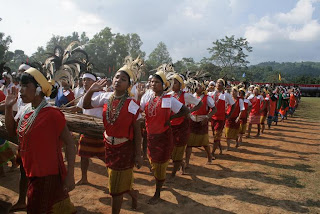 The annual Hundred Drums Wangala Festival of the Garos will be celebrated at Asananggre, 18 kms from Tura, the district headquarter of West Garo Hills on November 7 and 8, 2008.Hectic preparations are on to organize this Festival with the Hundred Drums Wangala Festival Organisation holding series of meetings every Friday for the last couple of months to chalk out the details for the celebration and to raise the required funds for the purpose.The Chief Minister of Meghalaya Dr. Donkupar Roy is expected to attend the Festival as the chief guest, besides hosts of dignitaries, tourists and media from the region and outside.Besides the usual rites associated with the Wangala Festival like the Rugala, Chachat So’a and Dani Doka, among others, there will be competition among the ten participating Wangala troupes from the three districts of Garo Hills, finally culminating with the main Hundred Drums Wangala dance. Troupe from Bangladesh will also be expected to participate in this year’s Hundred Drums Wangala Festival as a special appearance.
The annual Hundred Drums Wangala Festival of the Garos will be celebrated at Asananggre, 18 kms from Tura, the district headquarter of West Garo Hills on November 7 and 8, 2008.Hectic preparations are on to organize this Festival with the Hundred Drums Wangala Festival Organisation holding series of meetings every Friday for the last couple of months to chalk out the details for the celebration and to raise the required funds for the purpose.The Chief Minister of Meghalaya Dr. Donkupar Roy is expected to attend the Festival as the chief guest, besides hosts of dignitaries, tourists and media from the region and outside.Besides the usual rites associated with the Wangala Festival like the Rugala, Chachat So’a and Dani Doka, among others, there will be competition among the ten participating Wangala troupes from the three districts of Garo Hills, finally culminating with the main Hundred Drums Wangala dance. Troupe from Bangladesh will also be expected to participate in this year’s Hundred Drums Wangala Festival as a special appearance. 
It may be mentioned that the Wangala is the most significant post-harvest festival of the Garos, which is generally celebrated in the months of October and November. It is a thanksgiving ceremony to the Misi Saljong, also known as Pattigipa-Ra·rongipa (the Great Giver or the God of Wealth) for having blessed the humans with the rich harvest of the season.The Wangala has been practiced by the ‘Songsareks’ or non-Christian Garos from times immemorial in all the villages of Garo Hills, the time and mode of celebration varies from village to village. However, due to impact of modern civilization and foreign culture, the Wangala, which is the cultural identity of the Garos could be seen fast disappearing. So, in order to protect, preserve and promote this cultural identity, a group of Garo thinkers and leaders came together in a meeting and after a lot of discussion, they decided to organize the Wangala festival on modern lines: a group of 15-30 dancers with ten drums would form a contingent and ten such contingents with 300 dancers would make up the “Hundred Drums Wangala Dance Festival”.Thus, the first-ever Hundred Drums Wangala Festival was successfully organized on December 6 and 7, 1976 at Asananggre, the headquarters of Rongram Development Block. Since then, the Festival is being celebrated in the second week of November every year and over the years it has grown under the patronage of the Government of Meghalaya and nurtured by the Hundred Drums Wangala Festival Organisation.Presently, the Organisation is being led by Mr. Leander K Marak as its President, while the Block Development Officer, Rongram, Ms. Mary T. Sangma is the Ex-Officio Secretary.





